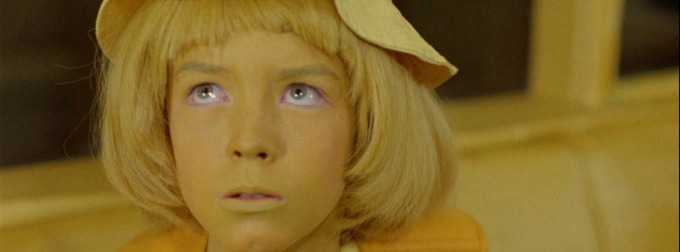At first sight this short feature film comes as a disappointment, if not a bit of an embarrassment. Can it really be the swansong of the great writing/directing team of Powell and Pressburger who gave the world THE RED SHOES, THE LIFE AND DEATH OF COLONEL BLIMP and (my own Desert Island movie) A CANTERBURY TALE? Not to mention the sensationally sadistic PEEPING TOM, widely reviled and believed to have put paid to Michael Powell’s career? After this lurid episode he lurched from one failed project to another, fetching up in Australia where he directed the raucous THEY’RE A WEIRD MOB (a strange film about Italian immigrants in Sydney, written under a pseudonym by Emeric Pressburger) and AGE OF CONSENT starring James Mason and a frequently naked Helen Mirren, setting the standard for the future.
And then THE BOY WHO TURNED YELLOW. The production was made for the Children’s Film Foundation on an extremely low budget and it shows. Flatly shot and even more flatly acted, it also suffers from the dire costumes of the early 1970s, bell-bottom trousers, tank-tops and mini-skirts which even the hero’s apparently non-imaginary friend Electronic (‘Nick’ for short) is obliged to wear, along with a rotating yellow light on his head.
Given that A CANTERBURY TALE’s inciting incident was a mysterious assailant who poured glue into women’s hair after dark, one shouldn’t be too surprised at the wacky development of Pressburger’s original story. After losing one of his two white mice on a trip to the Tower of London, schoolboy John Saunders catches the Northern Line home and promptly turns yellow, as do the rest of the passengers on the tube and part of the population of Hampstead. John is then visited in the night by the equally yellow Nick, who emerges RINGU-like from the TV set and takes John on a SNOWMAN-like tour of London’s power stations and eventually to the Tower, populated by Beefeaters with a traditional belief in capital punishment.
“… in the end it is the unpredictable story up there on the screen that counts …”
Herein lies THE BOY WHO TURNED YELLOW’s charm. The sheer wealth of dramatic incidents crammed into the short fifty-five running time of a film are all designed to inspire young imaginations. Where else would the action be held up by a goalkeeper complaining about a mouse in his shirt while trying to save a penalty? The budget may creak at the seams. The screenwriter Lem Dobbs (son of Michael Powell’s friend the painter R.B.Kitaj, who plays John’s geeky schoolmate Munro) describes supplying his own props and wardrobe. However, in the end it is the unpredictable story up there on the screen that counts — a message that clearly got through to Robert Eddison, the distinguished classical actor who was prepared to put up with any amount of indignity (not least with the costumes) in delivering a literally high-voltage performance as Nick.
So in the end a fitting swansong to the partnership which deservedly collected the children’s Film of the Year in both 1972 and 1973. And as with all Powell and Pressburger films from their glory years as ‘The Archers’, I look forward to seeing it again — especially for the yellow tube train coming into Chalk Farm Station.



One thought on “The Boy Who Turned Yellow”
Comments are closed.